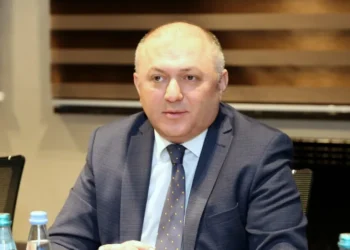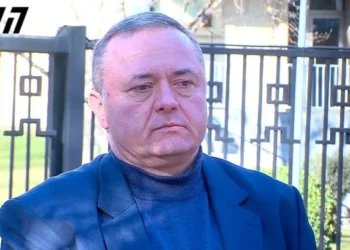President Volodymyr Zelensky of Ukraine said that Russia’s latest assault — launched just hours after US President Donald Trump postponed his planned meeting with Vladimir Putin — showed that Moscow “does not yet feel enough pressure to stop the war.”
On Wednesday, Russia carried out a sweeping attack across Ukraine, striking power plants, a kindergarten, and other civilian sites. At least six people were killed, and emergency crews in Kharkiv were seen rescuing children from a burning school building. The bombardment caused widespread blackouts, forcing Kyiv to impose emergency electricity restrictions for households and industry.
The strikes came shortly after President Trump announced that his long-discussed peace summit with Putin — previously expected to take place in Hungary — would be delayed. US officials said Moscow had again rejected proposals for a cease-fire that would freeze current front lines, insisting instead on maximalist territorial demands. While Trump publicly maintains his goal of brokering peace, Ukrainian officials believe Moscow uses these high-profile meetings to buy time and avoid consequences.
“Trump realized that this meeting would be a catastrophe — he’d gain nothing but shame,” said Mykhailo Samus, head of the New Geopolitics Research Network in Kyiv. “But the question is, will Putin manage to lure him back again?”
Despite Trump’s reluctance to supply long-range missiles to Kyiv, Zelensky continues to urge Western allies to increase pressure on Russia. “Every time the discussion about long-range capabilities fades, Moscow’s appetite for diplomacy vanishes,” he said.
Meanwhile, European nations have taken the lead in supporting Ukraine’s defense since Washington halted direct military aid. Zelensky is set to meet EU leaders in Denmark later this week to push for stronger collective action and a cease-fire based on current battle lines.
In the immediate aftermath of the kindergarten strike in Kharkiv, the battlefield picture remains intense and fluid. Russian forces claim to have captured three villages – Pryvillia in Dnipropetrovsk region and Pishchane and Tykhe in the Kharkiv region – as part of a modest territorial push in eastern Ukraine. Kyiv has not confirmed loss of those specific localities, reporting instead that six of seven attacks in the Tykhe area were repelled. President Putin said recently that Russian forces had seized nearly 5,000 km² of Ukrainian territory so far this year, claiming Moscow holds the strategic initiative across the 1,200-plus km front. Analysts caution the figure is likely inflated, and Ukraine reports still accumulating gains around Dobropillia and in Sumy region border zones. The situation around Kupyansk in northeastern Kharkiv remains especially precarious for Kyiv’s defenders, where authorities ordered the evacuation of hundreds of families amid sustained Russian pressure.
On the southern axis, although no major breakthroughs have been acknowledged publicly, Kyiv continues to emphasize counter-offensive probes and defensive depth. Russian forces remain focused on incremental advances, fortification of captured terrain, and attritional warfare rather than broad maneuver operations. The most recent assessment from the Institute for the Study of War (ISW) concluded that Russia’s tempo of operations is steady but not decisive. The front remains a slugfest, with Ukraine reporting heavy use of artillery, drones, and targeted strikes rather than sweeping advances.
On the infrastructure front, the attack on the Kharkiv kindergarten stands out as part of a broader Russian strategy to degrade Ukraine’s civilian energy and utility systems ahead of winter. On 21 and 22 October, drone and missile strikes hit the Chernihiv region and neighboring areas, killing at least four civilians, including a 10-year-old child, and plunging hundreds of thousands into blackout conditions. Ukraine’s energy ministry says Russia is using “double-tap” strikes — hitting a facility, then striking again when repair crews arrive — in order to overwhelm restoration capacity and sow fear among civilians. Over 140,000 consumers were reportedly left without power in Chernihiv region alone, with broader outages across Zaporizhzhia, Dnipropetrovsk, Kirovohrad, Poltava, Sumy and Odesa oblasts.
Meanwhile, Ukraine has intensified its own strikes deep inside Russia, targeting fuel and chemical plants to degrade Moscow’s logistic base. Ukrainian drones reportedly forced the shut-down of the Orenburg gas processing plant near Kazakhstan, operated by Gazprom, reducing Russian fuel export capacity significantly. Thus, both sides continue to target critical infrastructure — Russian strikes to erode civilian morale, Ukrainian strikes to undermine Russian war-economy linkages.
In military-aid and diplomatic developments, Kyiv secured a significant boost this week: Sweden and Ukraine signed a letter of intent in Linköping on 22 October to deepen air-force cooperation, paving the way for Ukraine to acquire up to 100-150 Swedish JAS 39 Gripen-E fighter jets in coming years.
President Zelensky expressed gratitude for approximately USD 4 billion in military assistance this year and said Ukraine expects to receive the first Gripens in 2026. Separately, Germany pledged more than USD 2 billion in military aid to Ukraine earlier this month, including air-defense systems, interceptor missiles, radar and precision-guided rockets. The new German package will include Iris-T surface-to-air systems, shoulder-fired missiles and radar equipment, reflecting Kyiv’s urgent need to bolster air- and missile-defense ahead of winter. These pledges come against concerns that Western military aid has slowed: data from the Kiel Institute suggests a 43 % drop in July–August 2025 versus earlier months. Meanwhile, diplomacy remains fraught: President Trump’s proposal to freeze the war at current front-lines was cautiously endorsed by Zelensky as “a good compromise”, yet he noted Moscow is unlikely to accept it. At the same time, Russian insistence on full control of the Donbas and Moscow’s withdrawal from the scheduled summit continues to complicate any major breakthrough.
Compiled by Ana Dumbadze














